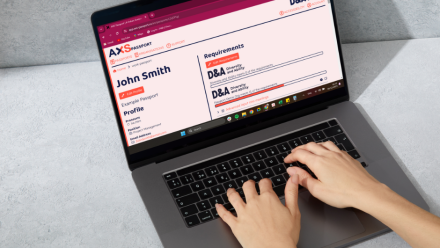Adjustments Without Labels: Enabling Neurodiverse Talent
3rd January 2025 by Scarlett James

Slowly but surely, the workplace is becoming more inclusive. We stay optimistic, but even organisations that declare themselves inclusive are behind on neurodiversity inclusion. Neurodiversity inclusion can’t be approached through ticking boxes with generic, one-size-fits-all adjustments; it’s about creating psychological safety and acknowledging the diverse experiences of neurodiverse individuals.
Knowing where to start is half the battle. That’s why we’ve gathered insights from industry experts and evidence-based, actionable strategies to help you build a culture where everyone can feel like they belong.
Not sure what neurodiversity means? Our blog has all the answers you need.
The power of psychological safety
Adjustments are essential, but they’re just one piece of the puzzle. It’s fantastic if your organisation has a robust adjustment process, but less so if employees don’t feel safe disclosing their neurodiversity in order to request said adjustments.
Neurodiverse employees—and all employees—thrive when we feel safe to express ourselves without fear of judgment. This feeling is widely referred to as psychological safety, the sense of comfort to be oneself and express oneself without being penalised. By prioritising psychological safety, organisations foster a workplace where neurodiverse individuals feel encouraged to share their ideas, struggles, and strengths, leading to stronger collaboration and higher job satisfaction.
How stereotypes impact psychological safety
In 2024, Professor Valeur joined Atif Choudhury (CEO, Diversity and Ability) for Labels and Legacies, a panel discussion exploring Neurodiversity Adjustments. She illustrated one way an organisational culture can lack psychological safety for neurodiverse people: through lack of awareness. Charlotte highlighted the stereotype of autistic people’s-perceived ‘lack of empathy’. “People say autistic people lack empathy, but all the autistic people I know, including myself, actually have masses of empathy. We feel it intensely when something happens that shouldn’t be.”
The double empathy problem explains how empathy may not be lacking in neurodiverse populations; it’s just experienced and expressed differently. Creating a workplace that genuinely values inclusion means moving beyond stereotypes. Empathy, in all its forms, is a two-way street; fostering understanding across neurotypes makes workplaces more supportive for everyone.
Key adjustments to support neurodiversity in the workplace
Organisations need to implement specific adjustments that address diverse needs to support neurodiverse employees fully. Here are some practical steps that help create a neurodiversity-friendly workplace:
- Flexible workspaces
Some employees may benefit from quiet, private work areas rather than open-plan environments, which can feel overwhelming. Offering flexible seating, quiet zones, or even noise-cancelling headphones can make a substantial difference. You can even offer your candidates a similar experience, for instance, suggesting they visit the office before their interview and showing them around to get a feel for the space.
- Clear and varied communication
Neurodiverse employees may prefer communication in different forms, whether through written instructions, visuals, or verbal follow-ups. As Charlotte said, “When people disagree with me, I find it annoying too, but I have to go towards it… Let’s have a conversation because I want to understand your perspective.” This openness to different forms of communication allows everyone’s voice to be heard.
- Structured work hours
Neurodiverse employees may particularly benefit from flexible or alternative working hours. Allowing employees to work when they feel most productive can make a significant difference in their engagement and performance.
- Assistive technology and resources
Using technology like voice-to-text software, grammar aids, or project management tools can support neurodiverse employees. For example, ADHD employees may benefit from task management apps, while those with dyslexia could use text-to-speech software. Explore what’s out there on our resources page.
Remember, your neurodiverse employees aren’t the only people who benefit from adjustments. Check out the seven workplace adjustments that you can make for everyone.
Building inclusive cultures with an anticipatory welcome
Creating an inclusive workplace isn’t just about adjustments- it’s about the culture. An anticipatory welcome acknowledges the challenges neurodiverse individuals face and creates a welcoming space before they even ask for help.
Why not check out our HR Zone article on how an anticipatory welcome can overcome pushback to EDI?
Fostering inclusion is not about “fixing” neurodiverse employees but about setting up spaces that are accessible and welcoming from the start.
As Atif said in Labels and Legacies: “We’re in a position where we can either pull up the ladder and say, ‘Well, I did it,’ or we can acknowledge that for many of us, it was about support—lots of love rooting for us along the way.”
One-to-one support for neurodiverse employees
Support for neurodiverse employees should be as unique as their individual experiences. Tailored, one-to-one guidance is a proactive way to address specific needs. Regular check-ins and an open channel for feedback can empower neurodiverse employees to express their needs and access resources without hesitation. As Atif highlighted, “Reach out to the most marginalised person on your team… ask them how they feel, whether they belong, and if they have ownership over their work.”
Offering this kind of targeted support ensures that no one is left behind and that neurodiverse employees feel genuinely valued and understood.
Celebrate unseen stories
Charlotte reminds us of the value in everyone’s unique story: “If you ever feel a person is boring, then you’re the one with the problem. All the moments in their life—even as a 10-year-old child—are unique to them.” Curiosity, respect, and empathy should drive our approach to inclusion, allowing us to appreciate each individual’s unique journey.
Neurodiversity in the workplace is more than making adjustments; it’s about understanding, supporting, and valuing the unique perspectives each person brings. Psychological safety, empathy, tailored support, and a commitment to inclusion create an environment where neurodiverse employees can thrive. As Charlotte and Atif powerfully reminded us, inclusion is a shared responsibility that we must actively embrace, ensuring every employee has a voice.
Want to create a workplace that truly values neurodiversity? Explore our Neurodiversity in the Workplace Training & One-to-One Support services today and start building a work environment in which every type of mind can thrive.


